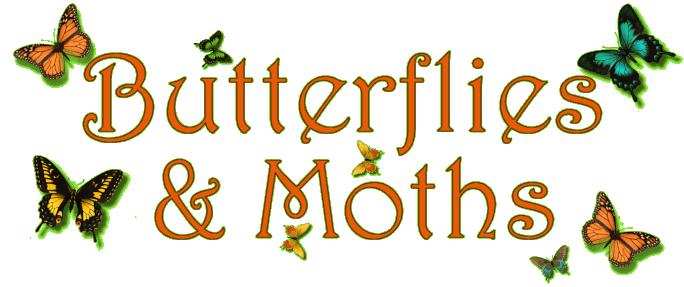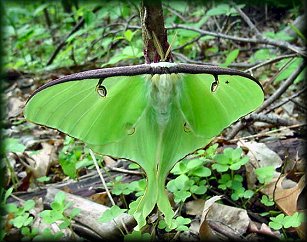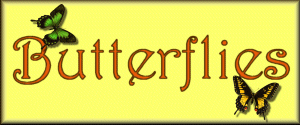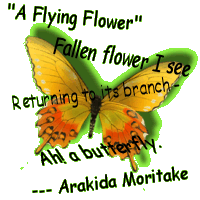 To a poet butterflies and moths are like flying flowers. Scientists know them as a group of insects that make up the order Lepidoptera, meaning "scaly wings." They are so named because their wings are covered with thousands of tiny scales. Under a microscope the wings are seen to be made up of millions of finely ridged scales that are arranged in overlapping rows. Each scale has a tiny "stem" that fits into a cuplike socket. The beautiful colors and markings of the insect are due to the scales, which come in a remarkable variety of colors. There are approximately 170,000 known species of Lepidoptera. About 1/10 of these are butterflies and the rest are moths. Because of their diversity and ability to adapt to virtually any climate, they are some of the most successful creatures on earth. They range in size from the tiny wingspan of the western pygmy blue butterfly (Brephidium exilis) of 5/8 of an inch to the giant wingspan of the Atlas moth (Attacus atlas) at up to 12 inches. Butterflies and moths look very much alike. The best way to tell them apart is to examine their antennae, or feelers. Butterfly antennae are slender and the ends are rounded into little clubs or knobs. Moth antennae lack these knobs and many of their antennae look like tiny feathers or are threadlike. Butterflies tend to be daytime flyers, while moths generally fly at night. Though both have species that fly at the opposite times. They also tend to rest in a different position. Butterflies tend to rest with their wings held together above their backs, while moths tend to rest with their wings folded over their backs. The honors for beautiful coloration are about evenly divided. The pale green Luna moth and the rich reddish brown Cecropia moth are as handsome as any of their cousins, the butterflies.
Different kinds of butterflies and moths live throughout the world in temperate regions, high in snowy mountains, in deserts, and in hot, steamy jungles. Everywhere but the arctic and antarctic regions. In North America, north of Mexico there are approximately 8,000 kinds of moths, but only 700 kinds of butterflies. Butterflies and Moths have a life cycle that consists of 4 phases: egg, caterpillar (larva), pupa (chrysalis), and adult. The egg phase is when the caterpillar develops in the eggshell. The caterpillar stage is a time when the insect feeds and grows, shedding its skin several times. It will first cut itself out of the eggshell, and usually eat the eggshell that provides nutrients that help it to survive until it finds food. During the pupa stage the caterpillar has chosen a place to attach itself, such as a leaf or stem, and develop into a pupa. At this time, the body breaks down its components and reforms itself into an adult butterfly or moth. The last stage, an adult, is when the butterfly or moth emerges to reproduce by laying eggs so that the entire cycle can begin again. This is called a complete metamorphosis.  Like all insects, the butterflies and moths have three pairs of legs and a body that is divided into three sections head, thorax, and abdomen. On the thorax, or middle section of the body, are two pairs of wings. The pair in front are usually the larger. The scales on the wings contain a pigment that gives the insect some of its color. Certain colors, however, and the iridescent shimmer come from the fine ridges on the scales. The ridges break up the light into the various colors of the spectrum. The beautiful blues, for example, are due to the way in which the light strikes the scales. A butterfly's antenna is a sense organ responsive to odor, touch, and possibly sound. They can perceive sound, but lack the complex hearing organs of many moths. These insects feed on the nectar of flowers and on other plant liquids. The mouth is a long slender sucking tube. When it is not in use it is coiled up like a delicate watch spring. By uncoiling the tube, the insect probes deep into the flowers and sucks up the nectar. Some kinds of insects have spines on the tip of the tube that tear the plant tissues of ripe fruits and start the juices flowing. As the adults visit the flowers in search of nectar, they rub against the stamens and pistils, and so help in the process of pollination. Survival. The key to survival in the caterpillar stage or the adult stage is to develop specialties by the insect, such as blending into the environment by mimicking leaves or twigs. Fright tactics can be used by the insect by developing patterns and spines can be used to frighten off predators. False eyespots on wing patterns will make the butterfly or moth seem larger and more frightening. Also the development of colors and patterns that resemble another poisonous insect will work for caterpillars, butterflies, or moths. For it won't take long for a predator to associate certain patterns or colors with tasting bad or even harming the animal. Tropical rainforests as well as the countryside in this country are now environments controlled by man. The clearing of the land and the draining of wetlands will destroy many habitats forever. In many parts of the world, butterflies and moths have decreased and many have become extinct. We must take steps to find out what is going wrong and correct it. Many species are allies of nature, helping in pollination of plants used for food or even new medicines yet discovered in the rainforests. So much has yet to be learned about butterflies and moths.  PHOTOGRAPHS PHOTOGRAPHS I have divided the photographs into two pages, one for butterflies and one for moths. The following "buttons" will take you to see the photographs that I have managed to get of each species, and a few caterpillars too.     References
Home Site Map Email at: dh @ naturehaven.com (Take out the spaces and this email address will work!) Please Read Guestbook ~~~ Please Sign Guestbook  Why more moths than butterflies here? They are easier to photograph, just turn on the porch light and wait a little while... But I'll try to track down a few more butterflies. And I have... |